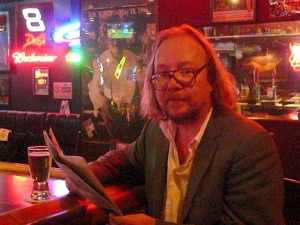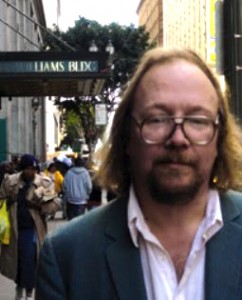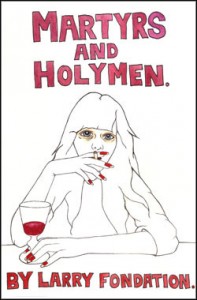BOOK REVIEW: MARTYRS AND HOLYMEN, Larry Fondation
By Eveline Morel | July 18th, 2013 | Category: Book Reviews, L.A. Art & Culture | Comments Off on BOOK REVIEW: MARTYRS AND HOLYMEN, Larry FondationThe beauty of starkness is the beauty of the harsh and the unforgiving. It is the aesthetic of emptiness and loneliness, belied by the hidden rattle and hum . . .
The parallels between the desert and the inner city seem to me to be both self-evident and uncanny:
Both stark, the shapes all-vertical and horizontal—with little in between, straight lines, high walls—covered with graphics: graffiti and petroglyphs.
The feeling of abandonment in both places is misleading—these environments are populated in their nooks and crannies, in vacant basements or underground burrows—punctuated by violence: the firing of weapons, the nighttime hunt of the owl, the click of a switchblade, the snake’s teeth snapping off the tail of the lizard—frightened, scampering, escaping with a third of its body gone and missing. Surviving still.
Much hidden life. Much nocturnal life. A quality of darkness that is truly dark. Light—when it appears—gloating with glare and grimace: the halogen streetlight and the desert sun.
Unforgiving.
In harsh locales, the furtive are the best adapted.
Beautiful.
Excerpt from “High Winds” in Martyrs and Holy Men, Larry Fondation
 Such is the vision of Los Angeles’s inner city, as portrayed in Larry Fondation’s latest collection of short stories Martyrs and Holymen. His powerful, gut-wrenching stories, real, stark visions of survival from L.A.’s underbelly, depict Skid Row heroes with the same mix of hope, passion, lust, and human foibles shared by all humans, rich and poor.
Such is the vision of Los Angeles’s inner city, as portrayed in Larry Fondation’s latest collection of short stories Martyrs and Holymen. His powerful, gut-wrenching stories, real, stark visions of survival from L.A.’s underbelly, depict Skid Row heroes with the same mix of hope, passion, lust, and human foibles shared by all humans, rich and poor.
Larry Fondation’s compact sentences pack a punch, and his portrayals mix poetry with the staccato rhythm of gunfire. Not without a reflective note, his narratives are often tinged with dark humor: “We had left the man alone among the rubble, with the rubble, in the rubble. As rubble. Like rubble. Blameless, struck no more, but there by himself (a man unfamiliar with Beckett, but waiting for Godot nonetheless).”
Larry Fondation’s version of L.A. noir blends the doomed, hopeless characters caught in their inescapable self-constructed prisons with this dark humor of absurdity, present in many of the stories: In “Peacekeeper” the UN Peacekeeper is powerless to stop the violence—he is left with two dead bodies of “innocent” bystanders, to “keep the peace,” as the captor walks off free. In another story, Kelso, the soldier who “fares well” under enemy fire, gets drunk, writes his name on all his limbs to identify his body parts in case they become severed, only to lose an arm in a shell attack the following day. . . .
Larry Fondation’s writing has its own brand of L.A. noir. The genre, developed out of the First World War and the Depression, continues to thrive, as it evolves, allowing us candid glimpses into the dark recesses of the human condition where monsters lurk and only shades of grey exist. Talking about his place in the L.A. noir genre, Larry explains that it’s “in a different sense from the way most Americans see noir . . . in my books, there are very few police officers and no detectives . . . That definitely separates me from most writers considered here in America to be Los Angeles Noir.” He adds, “The French view noir much differently from the way we do (my work gets a pretty good reception in France).There, any fiction that deals with gritty urban reality, the underbelly of life, qualifies as Noir. By that definition, my work is definitely noir.”
 Larry talks about his favorite L.A. noir authors. “I certainly admire classic L.A. noir. James M. Cain is foremost. And John Fante—if you’d call his work noir; again, the French would—and I would agree with the French. Camus’ “The Stranger” is a classic example of the broad definition of noir . . . But, back to L.A.: I like Ellroy—though his politics are terrible; and local writers who write about the poor—Gaty Phillips, Hector Tobar. And Michael Connelly and other more traditional LA crime writers are also quite good.Outside of just the confines of L.A., I identify with the more proletarian tradition of American writing—Crane, Wright, Dos Passos, and others.”
Larry talks about his favorite L.A. noir authors. “I certainly admire classic L.A. noir. James M. Cain is foremost. And John Fante—if you’d call his work noir; again, the French would—and I would agree with the French. Camus’ “The Stranger” is a classic example of the broad definition of noir . . . But, back to L.A.: I like Ellroy—though his politics are terrible; and local writers who write about the poor—Gaty Phillips, Hector Tobar. And Michael Connelly and other more traditional LA crime writers are also quite good.Outside of just the confines of L.A., I identify with the more proletarian tradition of American writing—Crane, Wright, Dos Passos, and others.”
But, as he says in a 2009 critique of L.A. Literature, entitled “Los Angeles Literature: Apocalypse, Redemption, and Reality,” published in Transfuge Magazine, “James M. Cain, Raymond Chandler, John Fante and Nathanael West all wrote about a Los Angeles they knew well—the hard-scrabbled L.A. of the Depression-addled 1930s. They wrote about the times they lived in and they wrote so well as to cast a spell on their successors and to create a vision and indelible image of LA for the world at large: L.A. as noir.” Since the Thirties, despite the good literary depictions of Los Angeles from Chester Himes, Bukowski, Joan Didion, Pynchon, and Christopher Isherwood, this L.A. noir vision has remained largely unchanged.
“Much of the writing associated with Los Angeles has only covered about 5% of our people and population,” he says, as he talks about the evolution of L.A. noir across the decades. “As with society in general, the poor often get left out. Some of the new noir writing has addressed that. I’ve mentioned Gary Phillips and Hector Tobar. There is some pick up of the Donald Goines and Chester Himes tradition there. And John Shannon’s Concrete River is an excellent book. So, yes, I think there is development—and it goes both forward and backward.”
The book is divided into sections whose titles are Latin citations. Why? “The use of Latin, a language obviously no longer used in practice, is deliberate. Clearly I’m not using it in a strictly, traditional Roman Catholic sense. But Graham Greene’s best books are permeated with the Catholic morality in which he was raised. One does not escape it. But rather one tries to cull the best parts . . . I grew up in Boston, very blue collar, in a pretty devout Roman Catholic family. The ritual of the church has continued to fascinate me. Despite the setbacks of the contemporary church, it has its place. Especially the social teachings. Though those teachings are not followed much in practice, they have continued relevance today. The idea of reflection, not consumerism. And especially the preferential option for the poor, which is the opposite of the social practice we pursue today in what amounts to totalitarian capitalism. I grew up Roman Catholic, but the basic morality is there in all faiths. So I use the tropes of the tradition I was raised in,” he explains.
 In Martyrs and Holymen, the large and small heroic acts are overshadowed by the dark side of human existence and the horrors of war. He incorporates stories of Iraq and Afghanistan veterans, Angeleno natives, transposing their war struggles with the struggle for survival back in L.A. We see the dark specters PTSD and the raw, unadulterated violence of war reflected in the first-person accounts of combat and wartime situations in Martyrs and Holymen. The returning Iraq war veterans is a new motif that emerges in this new collection of stories, as he reflects on how the defining moments of the 21st Century, 9-11, and the ensuing Iraq and Afghanistan wars affect the life of L.A.’s homeless population.
In Martyrs and Holymen, the large and small heroic acts are overshadowed by the dark side of human existence and the horrors of war. He incorporates stories of Iraq and Afghanistan veterans, Angeleno natives, transposing their war struggles with the struggle for survival back in L.A. We see the dark specters PTSD and the raw, unadulterated violence of war reflected in the first-person accounts of combat and wartime situations in Martyrs and Holymen. The returning Iraq war veterans is a new motif that emerges in this new collection of stories, as he reflects on how the defining moments of the 21st Century, 9-11, and the ensuing Iraq and Afghanistan wars affect the life of L.A.’s homeless population.
“I write a lot about the homeless,” he says. “Among the older generation of homeless people, a great many are Vietnam veterans. Sadly, among the new homeless will be a large number of vets from our desert wars. We treat the casualties of our imperialism very poorly. Of course, these abandoned vets—jobless, injured, hungry, homeless—will join the men, women, and children who have been casualties of our domestic war against the poor, which has been raging full force since the Ronald Reagan presidency.”
Drought, fire, flood and earthquake. The four seasons of Los Angeles.
Sunshine and noir. Paradise and Armageddon.
Riots and flames in 1965, and again in 1992. All cinder and ash.
The apocryphal tale of Lana Turner sipping soda at Schwab’s—discovered by Hollywood and going on to the bright lights of stardom.
There has always been the sense that opportunity looms large here; there has always been the sense that the world will end here.
Los Angeles is the ultimate city of duality.
Disaster films and fairy tales, fifty-room mansions and bungalows burning to dust in the Angeles National Forest.
It is ingrained deep in our imaginations—past and present, here and elsewhere. The world sees us like this; we show ourselves to the world like this.
Los Angeles is the most uncertain of cities.
Literature has helped form the image of the City. If it continues to do its job, it will also paint it new.
Excerpt from Los Angeles Literature: Apocalypse, Redemption, and Reality,” published in Transfuge Magazine, October 2009.
As literature continues to define L.A.’s self-image, Larry Fondation envisions the emergence of a new L.A. brand of Post Realist literature. “The next great Los Angeles novel will be post-realist . . . the future of American fiction—especially that rooted in Los Angeles—lies in its ability to reclaim its public function. Fiction about the world must replace fiction about the living room. Post Realists reposition plot, narrative attack, character development and non-linearity to covert political effect—not for didactic or polemical purposes, but rather to depict life as it is lived now. We live in an age of too much information, not a lack of information. Too little interpretation and elucidation, and too many random and unconnected factoids.We live in a time that witnesses the growth of poverty, not its reduction. The rise of violence at the expense of peace. An age of dissonance, not harmony. Official terrorism by the powerful and unofficial terrorism by the powerless. The challenge to all fiction is to witness and represent our times.”
Larry’s writing, although fictional, is very much based on the real life witnessed in his daily work as a community organizer in the South Central Los Angeles area. Watts, Compton, Inglewood, are neighborhoods he’s become intimately familiar with over the last 25 years, and not much different than the ones he grew up in Boston. “I got an education, and got out. Most of my friends didn’t,” he reflects.
The recent influx of investment capital transforming Downtown L.A. into a new hip, cool, urban center has not affected Skid Row. Its sad stories and hopeless heroes continue to exist a few blocks away from Gallery Row and the new lofts. Is there any hope for the downtrodden; will “the forgotten” always be there? As with his stories, where bright glimmers of hope shine through the pervasive “noir,” he retains a measure of optimism. “The situation downtown is a bit sad. While we need a vital urban core in the downtown area, it does not have to come at the expense of the poorest of the poor. The answer is always power. And power comes from organizing . . . I have a great deal of hope. People are resilient,” he says.“In many ways, the current situation is bleak. But so was the Robber Baron era and the time before the French Revolution . . . it is sad to see how far we have strayed. Perhaps Cain can be redeemed from slaying Abel, perhaps not. But, we have got to try.”








